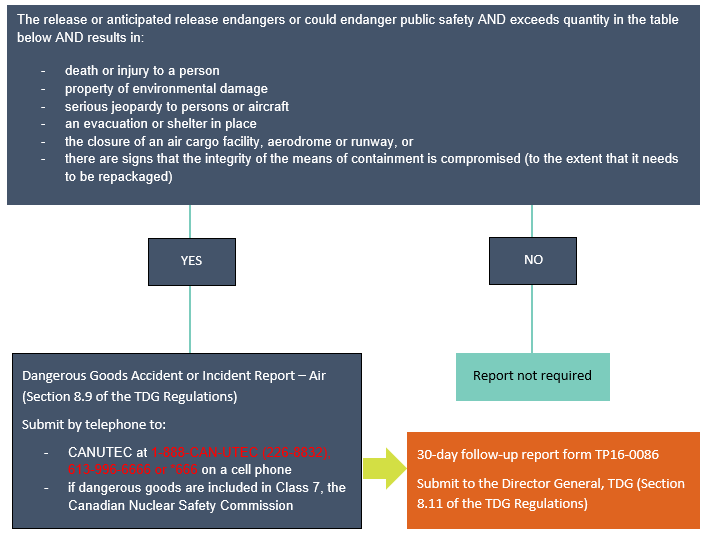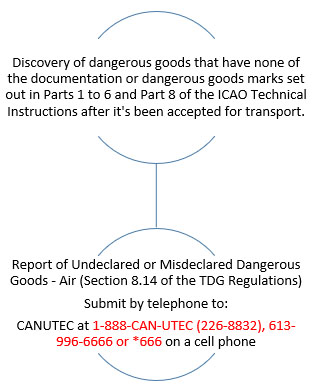Dangerous goods accident or incident report – air
The flowchart below should help you determine if you must make a dangerous goods accident or incident report for air mode (Section 8.9 of the TDG Regulations).
Description
Does the release or anticipated release endanger or could it endanger public safety?
Does the release or anticipated release exceed the quantity in the table?
Does the release or anticipated release results in: death or injury to a person; property or environmental damage; serious jeopardy to persons or aircraft; an evacuation or shelter in place; the closure of an air cargo facility, aerodrome or runway?
Are there are signs that the integrity of the means of containment is compromised?
- No : No further action required from a TDG perspective
- Yes : Dangerous Goods Accident or Incident Report – Air (Section 8.9 of the TDGR) must be made to : CANUTEC at 1-888-CAN-UTEC (226-8832), 613-996-6666 or *666 on a cell phone. Are the dangerous goods included in Class 7?
- No : Refer to the 30-Day Follow-up Report (Form TP16-0086)
- Yes : A report must be made to the Canadian Nuclear Safety Commission. Refer to the 30-Day Follow-up Report (Form TP16-0086).
| Class | Quantity |
|---|---|
| 1, 2, 3, 4, 5, 6, 8 or 9 | Any quantity |
| 7 | A level of ionizing radiation greater than the level established in section 39 of the Packaging and Transport of Nuclear Substances Regulations, 2015 |
Information to be included in the dangerous goods accident or incident report — air (Section 8.10 of the TDG Regulations):
- the name and contact information of the person making the report
- in the case of a release of dangerous goods, the date, time and geographic location of the release
- in the case of an anticipated release of dangerous goods, the date, time and geographic location of the incident that led to the anticipated release
- the name of the aircraft operator, aerodrome or air cargo facility
- the shipping name or UN number of the dangerous goods
- the quantity of dangerous goods that was in the means of containment before the release or anticipated release
- in the case of a release of dangerous goods, the quantity of dangerous goods estimated to have been released
- if applicable, the type of incident leading to the release or anticipated release
- a description of the means of containment containing the dangerous goods
- if applicable, the number of deaths and the number of persons who sustained injuries
- if applicable, an estimate of the number of people evacuated or sheltered in place
Undeclared or misdeclared dangerous goods report – air
The flowchart below should help you determine if you must make an undeclared or misdeclared dangerous goods report for air mode (Section 8.14 of the TDG Regulations).
Description
Discovery of dangerous goods that have none of the documentation or dangerous goods marks set out in Parts 1 to 6 and Part 8 of the ICAO Technical Instructions after it's been accepted for transport.
Report of Undeclared or Misdeclared Dangerous Goods (Section 8.14 of the TDGR) - CANUTEC at 1-888-CAN-UTEC (226-8832), 613-996-6666 or *666 on a cell phone.
Information to be included in the undeclared or misdeclared dangerous goods report – air (Section 8.15 of the TDG Regulations):
- the name and contact information of the person making the report
- the name of the aircraft operator, aerodrome or air cargo facility
- the names and contact information of the consignor and consignee
- the date of the discovery of the dangerous goods
- the shipping name or UN number of the dangerous goods
- a description of the means of containment containing the dangerous goods
- the total quantity or capacity of the means of containment and, if applicable, the total number of means of containment
- a description of the route by which the dangerous goods were to be transported, including the names of any aerodromes along the route
Dangerous goods occurrence report – air (ICAO)
The flowchart below should help you determine if you must make a dangerous goods occurrence report for air mode – International Civil Aviation Organization ICAO (Section 8.15.1 of the TDG Regulations).
Description
Flowchart for dangerous goods occurrence report (ICAO) - Air
Discovery, at an aerodrome or air cargo facility or on board an aircraft, of dangerous goods that have been transported on board an aircraft without:
- being loaded, segregated or secured in accordance with Chapter 2 of Part 7 of the ICAO Technical Instructions; or
- the pilot-in-command having been informed in accordance with section 7;4.1 of the ICAO Technical Instructions.
A dangerous goods occurrence report (ICAO) must be submitted to the Director General, TDG, within seven days following the discovery.
Information to be included in a dangerous goods occurrence report (ICAO) – air (Section 8.15.2 of the TDG Regulations):
- the name and contact information of the person making the report
- the name of the aircraft operator, aerodrome or air cargo facility
- the names and contact information of the consignor and consignee
- the date of the discovery of the occurrence referred to in paragraph 8.15.1(a) or (b)
- the shipping name or UN number of the dangerous goods
- a description of the means of containment containing the dangerous goods
- the gross mass or capacity of the means of containment and, if applicable, the total number of means of containment
- a description of the route by which the dangerous goods were, or were to be, transported, including the names of any aerodromes along the route
- a detailed description of the circumstances that led to the discovery of the occurrence referred to in paragraph 8.15.1(a) or (b), as the case may be


